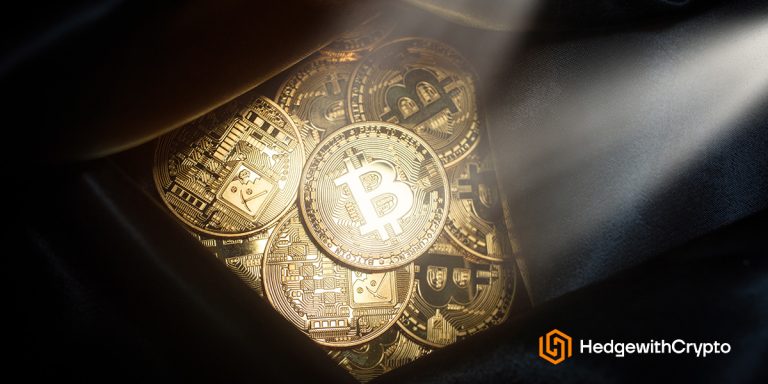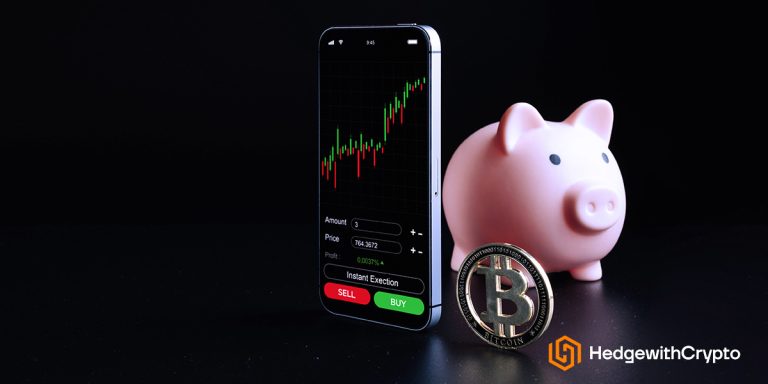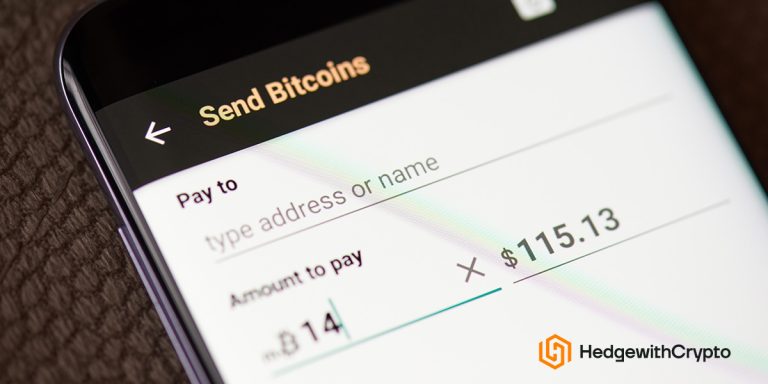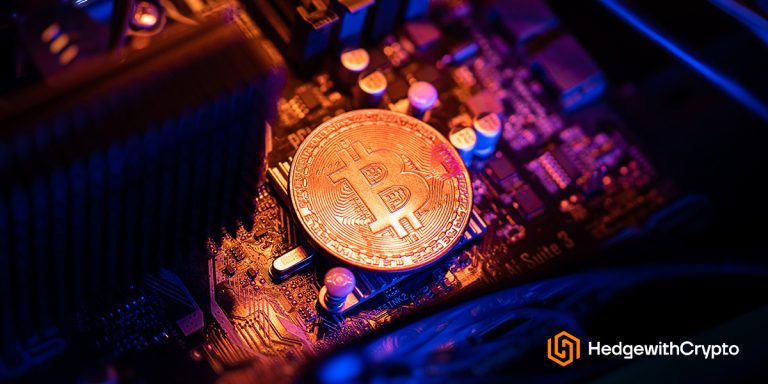We may earn a commission from links on our site, but this doesn’t affect our reviews. Learn more.
Hedge With Crypto is an independent publisher that provides objective and free content. Articles on our site may include links to our partners. If you click on these links, we may earn a commission. However, our editorial content remains unbiased, reflecting our own opinions or the general information available. For more information on our company policies, read the Affiliate Disclosure, Privacy Policy, and Terms & Conditions.
11 Best Bitcoin Mining Pools
Hedge With Crypto aims to publish information that is factual and accurate as of the date of publication. For specific information about a cryptocurrency exchange or trading platform please visit that provider’s website. This information is general in nature and is for education purposes only. Hedge With Crypto does not provide financial advice nor does it take into account your personal financial situation. We encourage you to seek financial advice from an independent financial advisor where appropriate and make your own enquiries.
TABLE OF CONTENTS
Based on our reviews, these are the top Bitcoin mining pools to use based on important factors such as reputation, pay-out scheme, user-friendliness, security, supported cryptocurrencies, fees, customer support, and reviews.
- Binance Pool (best mining pool)
- Slush Pool (best for reputation)
- Antpool (best for ease of use)
- F2Pool (best for merged mining)
- BTC.com (best for security)
- Foundry USA (best for large miners)
- EMCD (best for mining ecosystem)
- P2Pool (best for decentralization)
- ViaBTC (best for features)
- PegaPool (best eco-friendly mining pool)
- Poolin (best for customer service)
Featured Partner
Kraken
Crypto platform for smarter investing.
4.8 out of 5.0
Kraken is a US-based crypto trading platform that is best suited for users who need crypto-to-fiat and crypto-to-crypto trading facilities. One of the most regulated and security-focused exchanges, Kraken is a great choice.
200+
USD, GBP, EUR, CAD, CHF, JPY & AUD
Bank transfer, SWIFT, SEPA, debit and credit card
0.16% (maker) and 0.26% (taker)
Best Bitcoin Mining Pools Compared
| Bitcoin Mining Pool | Mining Fees | Pay-out Method |
|---|---|---|
| Binance Pool | 2.5% | FPPS |
| Slush Pool | 0% – 2% | Score system |
| F2Pool | 2.5% | PPS+ |
| AntPool | 0% (PPLNS), 4% (PPS+) | PPLNS & PPS+ |
| BTC.com | 4% | FPPS, PPS |
| Foundry USA | 0% | FPPS |
| P2Pool | 1% | PPLNS |
| ViaBTC | 2% (PPLNS), 4% (PPS+) | PPLNS, PPS+ |
| Pega Pool | 1% – 2% | FPPS |
| Poolin | 2.5% | FPPS |
Why We Picked These Bitcoin Mining Pools
1. Binance Pool
Binance Pool otherwise known as Binance Smart Pool is a cryptocurrency mining service offered to its users on its global trading platform, Binance. Existing users on the platform can participate in the mining pools to earn rewards on Proof-of-Work (PoW) coins such as Bitcoin. Since the establishment of Binance Pool, it has grown in popularity. It is currently the 5th largest Bitcoin mining pool based on hash rate distribution with nodes in America, Europe, Southern China, Northern China, and other regions.
The advantage of using Binance Pool is the strong foundation established within the Binance ecosystem, which is a proven leader in technology, innovation, and security. Moreover, users have access to the broad range of products and services offered on Binance, such as the Bitcoin wallet, exchange, DeFi features, staking, and trading exchange.
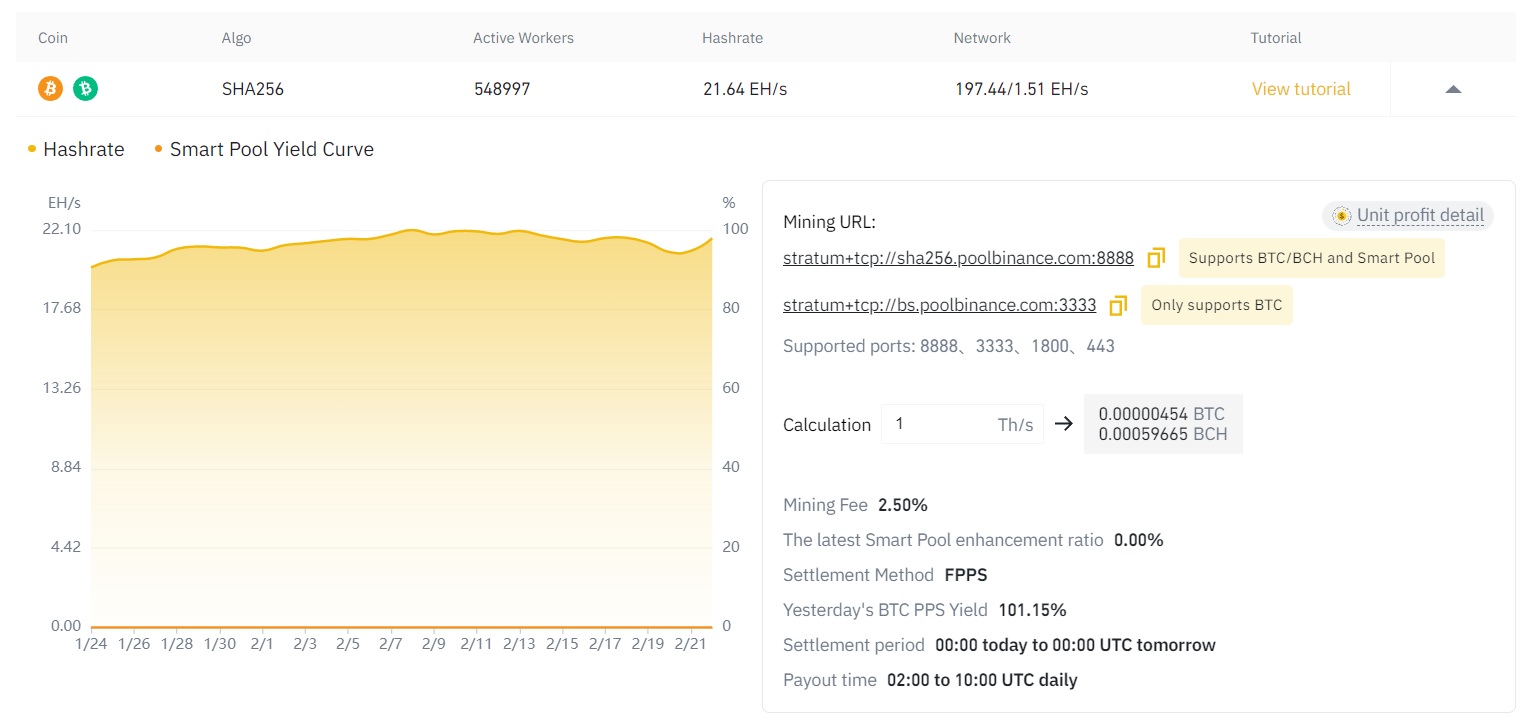
Binance Pool uses the FPPS payout model for Bitcoin, which means instant settlements and fewer fluctuations in earnings. The service goes to a higher payout than a standard FPPS model due to the real-time hedging of the Smart Pool, which is a pro. Should there be a situation where the actual payout is less than FPPS, Binance Pool guarantees to compensate for users’ losses.
All settlements are paid to the user's Binance wallet, which can be used on the exchange or withdrawn to an external wallet (read our full tutorial on withdrawing from Binance). The revenue earned from Binance Pool can be managed and monitored using the Binance App.
In terms of fees, there is a 2.5% mining fee which is higher compared to other mining pool providers which offsets the guaranteed higher pay-outs from real-time hedging. However, overall Binance Pool is one of the best Bitcoin pools as it is straightforward to use, safe and reliable.
Read our full Binance review.
Binance Pool Pros:
- Access to broader crypto products
- Safe and reliable website
- Guarantees payout for losses in pool
Binance Pool Cons:
- 2.5% mining fee
2. Slush Pool
Slush Pool was the first Bitcoin mining pool ever established. Since launching in 2010 as “Bitcoin.cz”, the pool has helped to mine over 1.28 million BTC. Although initially operated by members of Satoshi Labs, the creators behind the Trezor wallet, the pool is now run by a Bitcoin mining company called Braiins which was founded shortly after Slush Pool began.
The platform publishes mining activity through statistical proof, which is why SlushPool has become known for its stability and accuracy. It is, therefore, often considered one of the more transparent mining platforms. The user interface is user-friendly and has a demo account for users to familiarize themselves with the native dashboard. Support is offered in multiple languages, including English, Russian, German, and Chinese. For those who are on the go, the mining pool statistics can be reviewed using the pool’s native mobile application.
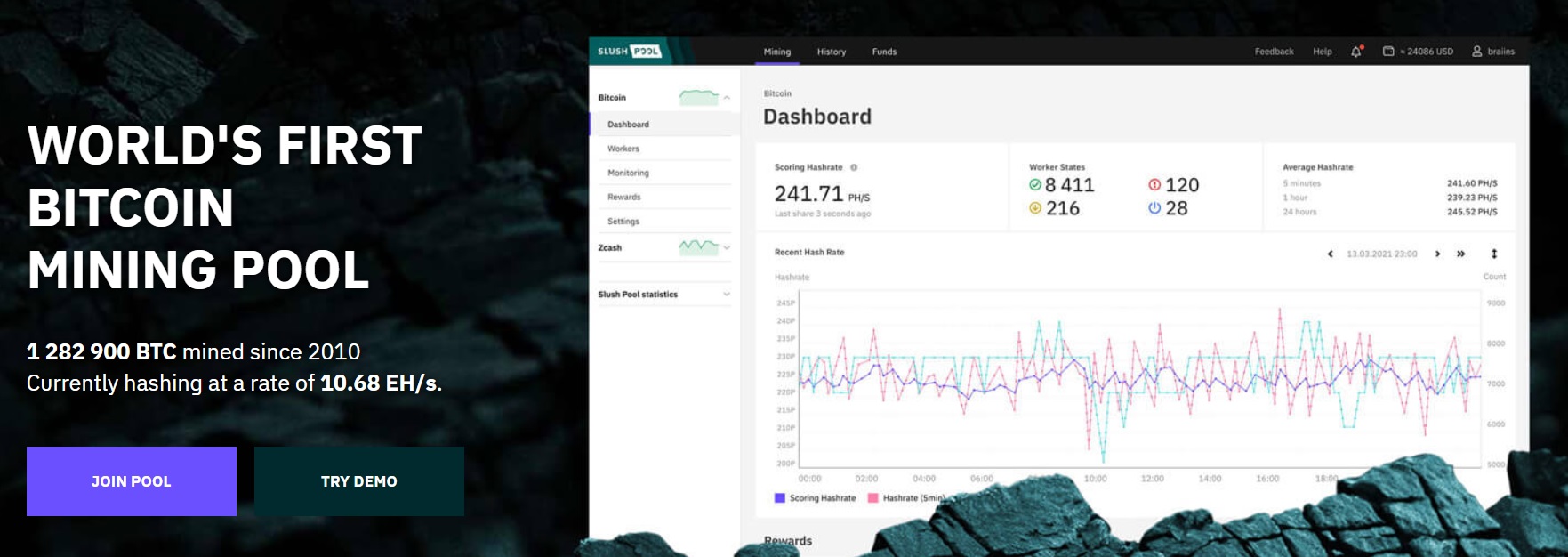
Rewards at Slush Pool are distributed via a “Score” system, which measures a miner’s scoring hash rate. The scoring hash rate reflects how much computer power is contributing to the mining pool. Rewards are then calculated proportionally. BTC is only distributed if a block reward is found and a 2% fee is implemented. Alongside BTC, users also have the opportunity to mine the privacy-focused Zcash and earn ZEC rewards.
To help improve the efficiency of Bitcoin mining, in addition to the operation of the mining pool, Braiins developed its proprietary Bitcoin mining software known as BraiinOS and BraiinsOS+. In particular, BraiinsOS+ helps to autotune and improve the efficiency of mining hardware. By using BraiinsOS+ users can enjoy increased hashrate from Bitcoin ASIC miners and 0% pool fees instead of the standard 2%.
Slush Pool Pros:
- No mining pool fees
- Demo mode to learn how to mine in the pool
- Mobile app to monitor mining pool
Slush Pool Cons:
- It might be intimidating for first-time miners
3. AntPool
After launching in 2014, AntPool has focused on becoming one of the top Bitcoin mining pools in the market. The pool has successfully held the top spot for Bitcoin hash rate on multiple occasions in the past. AntPool is operated by Bitmain Technology, which also manufactures the famous Antminer ASIC series.
The company hosts Bitcoin mining servers worldwide, which are connected to a peer-to-peer network. All miners are connected to their nearest server geographically. Thanks to an increased presence, AntPool offers services to a range of customers with 3 mining modes to choose from:
- Stratum (used for traditional pool mining)
- P2Pool (for creating a single group of miners)
- Solo (for mining farms and individuals that can generate high hash rates)
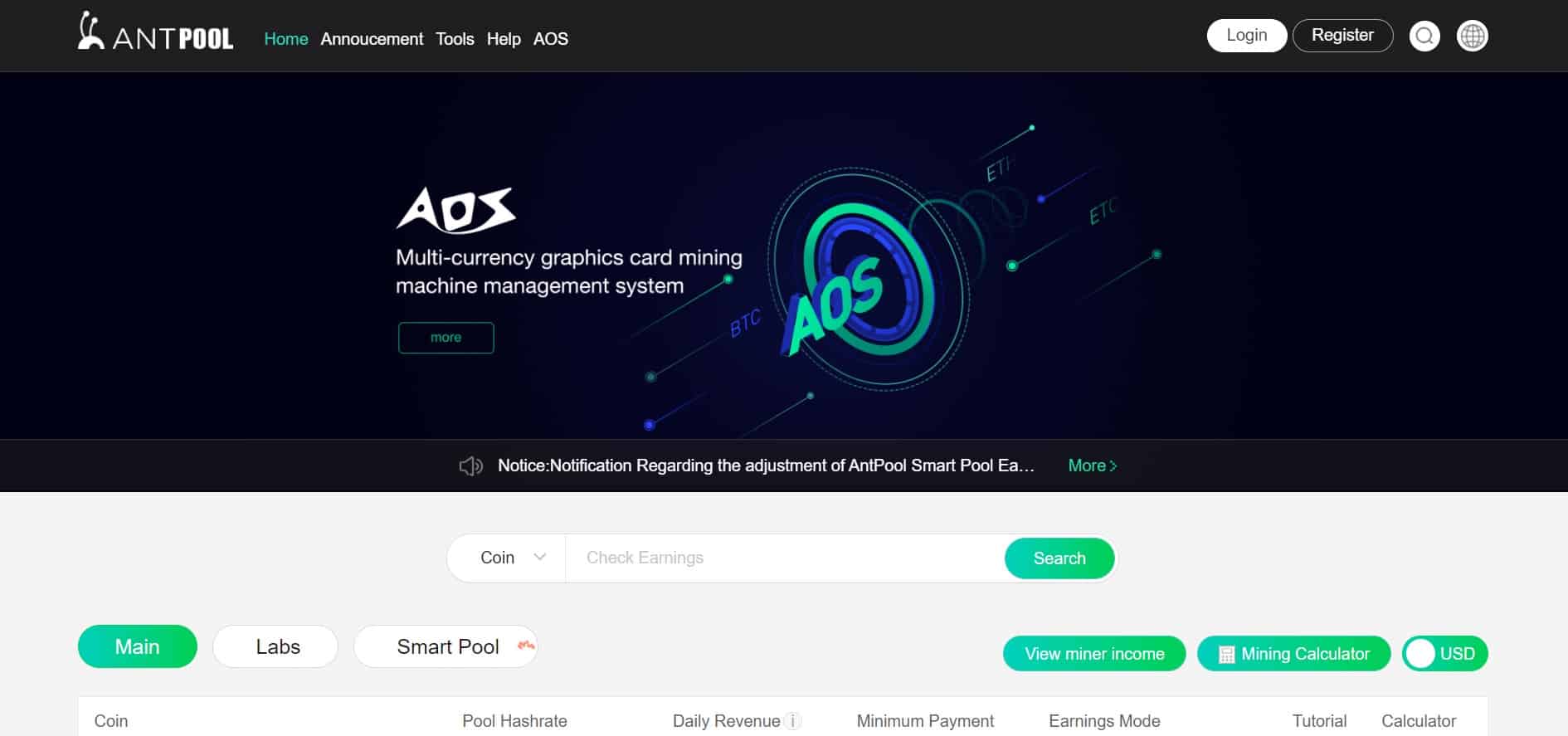
Above all else, the company has focused on building a user-friendly experience and a wide range of payment schemes. Alongside a friendly user interface, earnings can be distributed via PPS+ or PPLNS, both associated with an independent fee. PPS+ can be used for a 4% block fee, while PPLNS can be used for a 0% block fee. All rewards are distributed daily, and assets are protected with 2FA and log-in notifications.
Alongside BTC, the mining platform allows users to mine several other cryptocurrencies, unlike other mining pools. These include ETC, BTM, SC, ETH, DASH, XMC, LTC, ZEC, and BCH. All mining activity can be monitored from the platform’s mobile application and support is offered on a 24/7 basis via a ZenDesk ticketing system.
AntPool Pros:
- Flexibility to choose from several mining pools
- Earnings can be distributed via PPS+ or PPLNS methods
- Suitable for mining Bitcoin and several other coins
AntPool Cons:
- Poor customer feedback on AntPool app
4. F2Pool
F2Pool, also known as Discus Fish to members of the crypto community, was first launched in 2013. It was one of the earliest mining pools to grace the industry and remains China’s oldest. Used by over 2 million miners worldwide, F2Pool has now become one of the most popular and is currently the 2nd largest pool for hash rate distribution at 14.8% of blocks mined. After successfully launching a Bitcoin-focused pool, the platform expanded into other cryptocurrencies and even supports non-custodial ETH 2.0 staking with a minimum of 0.1 ETH.

Alongside BTC, other cryptocurrencies can be mined, including ETH, LTC, ETC, BCH, CKB, RVN, ZEC, ZEN, KDA, DCR, and DASH. Some of these can be combined in what F2Pool terms “merged mining”. Merged mining allows users to apply the work completed for one blockchain to others. This means that users can earn extra coins without using more hash rate, which is a great feature.
Rewards are distributed on F2Pool via a PPS+ payout scheme. In addition to a share of block rewards, miners are rewarded with a 3% bonus as a loyalty reward for using the pool. A 2.5% fee will be charged. Minimum withdrawals for F2Pool stand at 0.001 BTC, which is very reasonable.
F2Pool Pros:
- Large number of miners with good hash rate distribution
- Supports a wide range of crypto mining pools besides Bitcoin
F2Pool Cons:
- 2.5% mining fee is applied
5. BTC.com
Marketed as “the world’s leading multi-currency integrated mining pool”, BTC.com has focused on providing users an easy-to-manage platform for multi-currency mining. The company was established as a blockchain explorer in 2015 and developed a Bitcoin mining pool in 2016. Like AntPool, BTC.com is managed by Bitmain Technologies.
BTC.com hosts multiple servers worldwide, which are connected to a peer-to-peer network. Miners typically join the geographically closest server. The code behind the mining platform is completely open-source and can be verified for accuracy. The open-source nature has also helped to legitimize the project. The management of BTC.com mining can be observed from the native BTC.com mobile application, which provides a friendly and intuitive interface for miners.
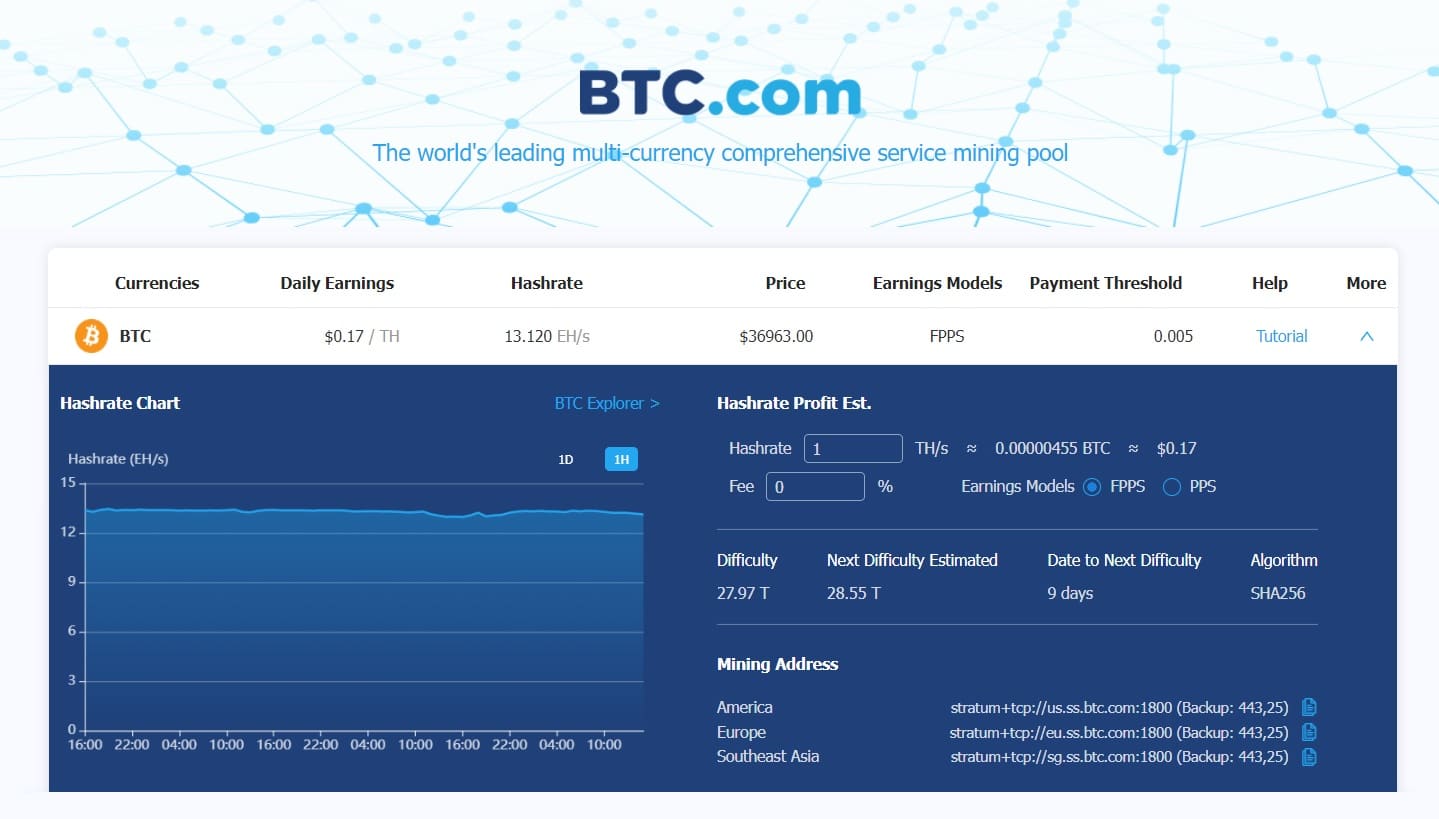
Users can mine BCH, LTC, ETH, DCR, and CKR in addition to BTC. For BTC, rewards are distributed using an FPPS payout scheme that implements an average fee of 4%. All other rewards are either paid out via FPPS or PPS payout schemes.
In addition to transparency, BTC.com prioritizes security. The platform implements several security measures to discourage the mismanagement of funds and maintain the network's stability. All data reading and writing are separated, and the platform hosts Cloudflare to protect users from a Distributed Denial-of-Service (DDoS) attack. In short, BTC.com is a reputable, secure, and trustworthy Bitcoin mining pool.
BTC.com Pros:
- P2P mining pool servers with open-source architecture
- One of the better mining pool apps
- Intuitive website that is easy to use
BTC.com Cons:
- 4% mining pool fee
6. Foundry USA
Built as the U.S.’s answer to a Chinese-dominated market, the Foundry USA Pool was first launched in 2019 by Foundry, a subsidiary of Digital Currency Group (DCG). DCG subsidiaries also include CoinDesk, Grayscale, Genesis, and Luno. Although Foundry USA entered the marketplace much later than competitors, as a result of the Chinese ban on Bitcoin exchanges and mining in 2021, the pool has moved into a commanding position and is currently the largest Bitcoin mining pool in the world with a market share of 16.69% at the time of writing.
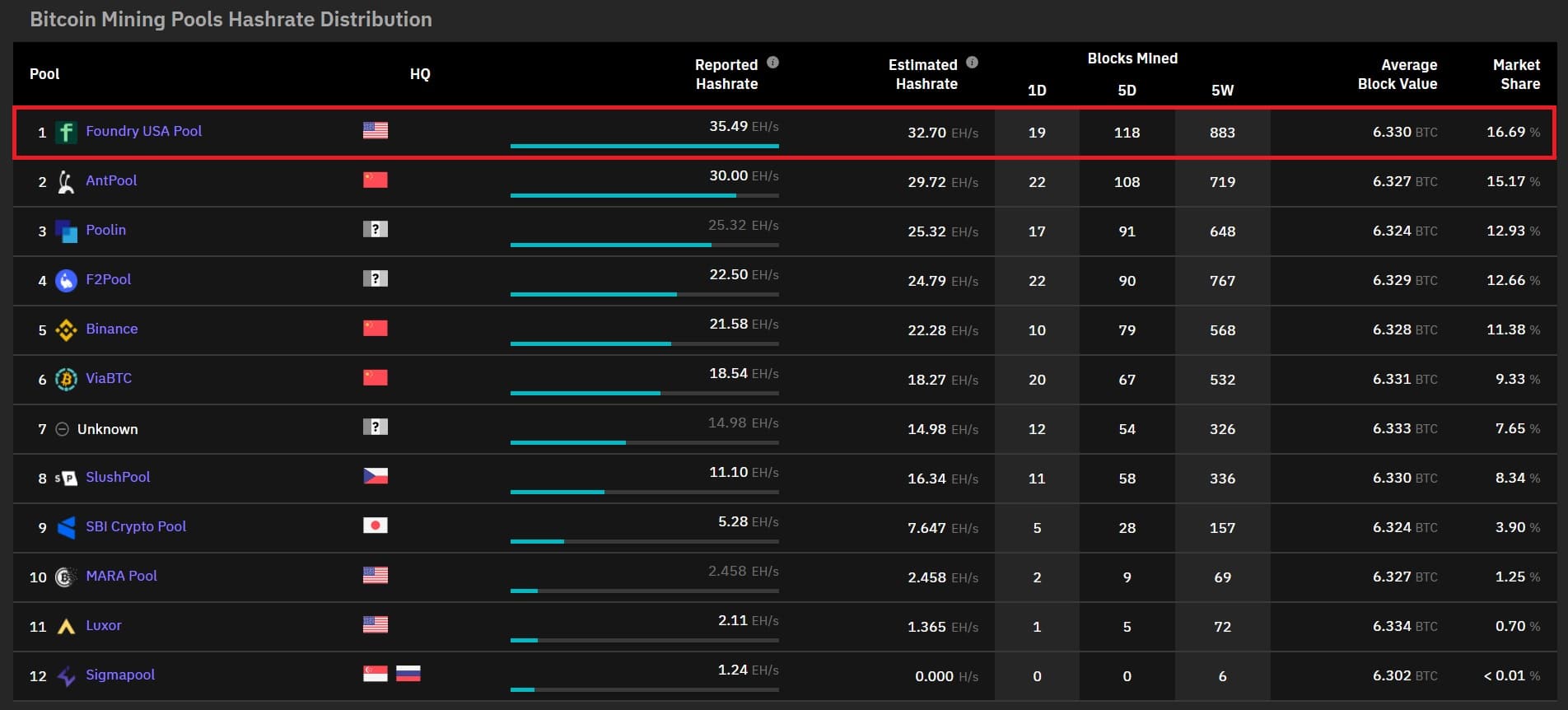
Foundry USA focuses on miners with large hash rates. These may include organizations or individuals, but the company aims to become a specialist in providing mining machines, capital, and professional expertise to up-and-coming bitcoin miners in the U.S. While smaller entities can use the pool, Foundry USA requires higher computing power.
The mining pool supports BTC and BCH and implements an FPPS payout scheme with 0% pool fees. However, this is currently unverifiable via the company’s website, as all interested parties need to apply for access via a form found on Foundry’s website. In addition to mining expertise, the platform offers a connection with FoundryX, a new marketplace for buying and selling mining equipment. Moreover, individuals can stake cryptocurrencies to earn passive rewards through FoundryStaking, which supports the top Proof of Stake (PoS) protocols for staking.
Foundry USA Pros:
- One of the largest Bitcoin mining pools in the world
- Offers good hash rates for serious miners
- 0% mining pool fees
Foundry USA Cons:
- Hash rates are not competitive for smaller miners
7. EMCD
EMCD is one of the leading software developers for mining and transferring crypto assets. One of the first of its kind, EMCD was established in 217, earlier than most other platforms in this list. Today, it is in the top 10 Bitcoin mining pools and has amassed over 270,000 customers.
EMCD is a BTC pool with algorithmic switching where custom firmware maximizes hash rates. Other items of note are the 1.5% fee and daily payouts. However, the platform has created an entire ecosystem to complement its mining capabilities.
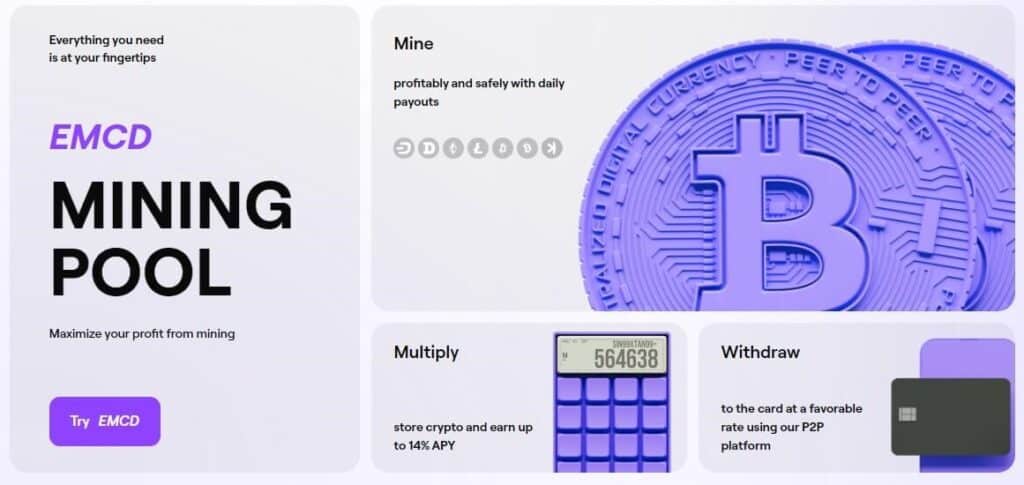
The EMCD wallet allows users to exchange cryptocurrencies and withdraw them to a Visa or Mastercard. Nine cryptos, such as BTC and USDT, are supported, and there are zero withdrawal fees for transfers of supported crypto to external wallets. The Coinhold feature allows users to passively earn yields up to 14% APY on USDT, BTC, USDC, ETH, LTC, and BCH, and assets can be withdrawn at any time. It also has a Peer-to-Peer (P2P) marketplace where customers can buy and sell fiat and digital currencies to other EMCD users with no fees. Numerous payment options are available including bank transfers and digital payment systems.
EMCD's apps are available to iOS and Android mobile device users. It is an all-around Bitcoin mining platform with outstanding security and complementary features.
EMCD Pros:
- Good hash rates
- Daily payouts
- Ecosystem of supplementary features
EMCD Cons:
- 1.5% mining fee
8. P2Pool
Often described as a cross between solo mining and pooled mining, P2Pool is a decentralized mining alternative. The idea behind the mining pool was first developed in 2011 to support the decentralization of the Bitcoin mining process and Bitcoin blockchain protocol. Many in the industry were concerned that centralized mining pool operators would gain too much influence over transactions processed on the blockchain.
Like pooled mining, all hash rates are still combined, but unlike pooled mining, there is no centralized entity in control of the blocks generated. Even if P2Pool managed to secure over 50% of the Bitcoin mining hash rate, there is no danger of a 51% attack because each block is still being created by individual miners.
Related: Can Bitcoin be hacked in a 51% attack?
A key element to P2Pool is known as the “sharechain”, which is a sidechain running in parallel to Bitcoin. Each miner in P2Pool focuses on solving blocks of the share chain, which can be found much quicker due to a lower difficulty setting. However, these blocks are still fully functioning Bitcoin blocks. As a result, every so often, a true Bitcoin block is found and posted to the Bitcoin blockchain for BTC rewards. Rewards are then distributed among all P2Pool contributors using the sharechain. The number of rewards is proportional to the number of share chain blocks an individual miner has created.
Like solo mining, this means that rewards are distributed randomly, dependent on when BTC block rewards are found. Therefore, the variance of block rewards will be slightly higher than in traditional mining pools. However, as the number of miners searching for blocks is higher, the level of rewards is reportedly similar.
While the level of control offered by P2Pool may be attractive to some miners, it is worth mentioning that the setup is technically complex. As there is no centralized operator, there is also very little support if things go wrong.
P2Pool sets a 1% fee by default, however, the fee is an optional donation to help the development of P2Pool.
P2Pool Pros:
- One of the largest Bitcoin mining pools in the world
- Good hash rates
- 0% mining pool fees
P2Pool Cons:
- No customer service to help with troubleshooting
9. ViaBTC
ViaBTC is a Bitcoin mining pool that was first launched in 2016. The platform focuses on providing its customers a professional and transparent mining service. Although slightly younger than competing mining pools, the operator now serves over 1 million miners in over 130 countries and has developed a respectable reputation among cryptocurrency miners. ViaBTC supports many cryptocurrency mining services besides Bitcoin, such as BCH, BSV, FCH, ETH, ETC.
ViaBTC has focused on producing an encompassing ecosystem for Bitcoin miners that offers a broader appeal than its competitors. The platform offers a mining pool, ViaBTC wallet, CoinEx exchange and Smart Chain access, and OneSwap’s decentralized exchange. In addition to the impressive ecosystem, ViaBTC has developed unique features to enhance the mining experience. These include smart mining and a one-click switch.
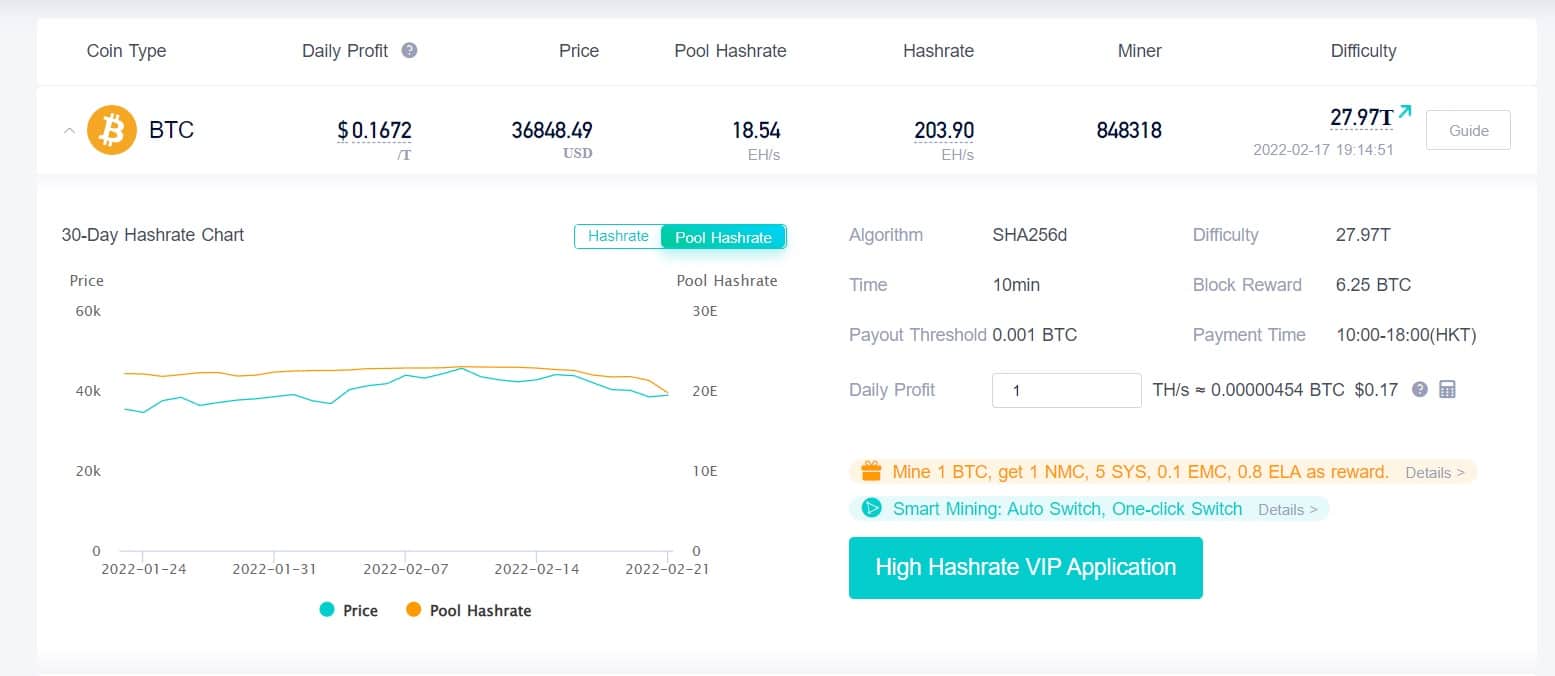
Both smart mining and one-click switch options are situated within the umbrella of the “smart mining” module. Smart mining enhances returns by implementing an algorithm to switch between mining preferences. Likewise, the one-click switch allows users to switch hashrate between multiple cryptocurrencies without changing configurations. Smart mining is available in the Bitcoin pool, which includes BTC and BCH. The one-click switch is also available in the Zcash pool, consisting of ZEC and ZEN.
Rewards on ViaBTC are distributed through PPS+ and PPLNS payout schemes. PPS+ is charged a 4% block fee, and PPLNS charges a 2% block fee. The profitability for each payout scheme can be calculated using the platform’s pool hash rate chart.
Support is offered in multiple languages via an online ticketing system, and assistance can also be found in the platform’s comprehensive help center guides.
ViaBTC Pros:
- Supports a wide range of crypto mining pools
- One-click mining pools
- Flexibility of PPS+ and PPLNS payout schemes
ViaBTC Cons:
- Mining pool fees
10. PegaPool
Based in the UK, Pega Pool is a top 10 Bitcoin mining service gaining popularity. Pega Pool is part of a network of crypto mining and blockchain services. The team behind the Bitcoin service comprises experienced miners to provide the best Bitcoin mining operation for individuals.
The Bitcoin mining service distinguishes itself in the mining industry, focusing on sustainability and reducing its carbon footprint. Carbon impacts associated with the energy-intensive process of mining Bitcoin are offset by the planting of trees. To date, 193,913 trees have been planted for miners that use non-renewable energy, offsetting approximately 5,164 tonnes of carbon.

Importantly, PegaPool has one of the highest revenues per TH in the industry to maximize the value for miners. Regarding costs, the maximum fee users will be charged for using the service is 2%. However, miners who opt to participate in the mining service that utilizes renewable energy sources are rewarded with a reduced fee of 1%. With incentives to use renewable energy and its tree planting program to offset its carbon footprint, Pega Pool is the world's first eco-friendly Bitcoin mining service worth considering.
PegaPool Pros:
- Only eco-friendly Bitcoin mining pool
- Well-designed website to get started and join a pool
- High revenue per TH
PegaPool Cons:
- Not as well-known as the larger mining pools
11. Poolin
Branded as “more than just a mining pool”, Poolin is one of the youngest Bitcoin mining pool operators. But that doesn’t mean Poolin is one of the smallest. Although the platform only launched in 2018, thanks to a wide range of quality services, the Bitcoin mining pool soared into the top 5 hash rate spots. In addition to the Bitcoin mining pool, Poolin also offers a hosting service to host a range of ASIC mining equipment.
Like F2Pool, Poolin offers a merged mining feature that allows users to mine multiple cryptocurrencies using the same computing power. Poolin also offers an auto-switch feature that automatically switches the hash rate between BTC and BCH, depending on which can offer the best mining profitability. All rewards are distributed using an FPPS payout scheme, which charges a 2.5% fee.
The customer service offered at Poolin also helps it stand out from the crowd. A customer service representative can be accessed for one-on-one queries, and the mining pool’s Telegram community greatly enhances communication between users and Poolin staff.
Poolin Pros:
- Mine multiple cryptos on one platform (merged mining)
- Supports a wide selection of ASIC mining hardware
Poolin Cons:
- 2.5% mining pool fees
This Is What You Should Look For In A Bitcoin Mining Pool
Picking a Bitcoin mining pool to join can be confusing and difficult for beginners. To reduce the risk of any issues or troubles mining Bitcoin in a pool, it is important to consider and research certain factors, such as reputation, pay-out scheme, user-friendliness, security, supported cryptocurrencies, fees, customer support, and reviews.
- Pay-out schemes. There is no set pay-out scheme for Bitcoin mining pools. The two main pay-out schemes employed include (1) pay-per-share and (2) pay-per-last-N-shares; however, variations are also built using those strategies. A miner needs to understand the pay-out scheme, how often rewards will be distributed, and whether a minimum withdrawal limit is implemented.
- User-friendliness. Bitcoin mining can be a technically daunting endeavor. The more user-friendly a Bitcoin mining pool operating platform is, the less likely mistakes will be made.
- Fees. Most mining pool operators charge a maintenance fee for the services provided. These fees eat into profits earned from Bitcoin mining and are crucial to understand. Due to the number of mining pay-out schemes, there is often not one set fee implemented for an operator.
- Security. Like cryptocurrency exchanges and other crypto-related platforms, security for Bitcoin mining pool platforms should be a top priority. Common security methods to look out for with Bitcoin mining pool operators include two-factor authentication and log-in notifications.
- Supported crypto. While having the ability to mine Bitcoin is key, several mining operators now offer the ability to mine a wide range of other cryptocurrencies. This may be attractive for some miners with extra computing power.
- Customer support. For those new to Bitcoin mining, customer support will likely be an important factor in assisting with troubleshooting queries. Experienced Bitcoin miners are less likely to depend on customer support services.
- Reputation and reviews. Bitcoin mining pools have been exploited in the past. Mining pool operators have also used the computing power of others to further their own ends. All of these scenarios affect the overall reputation of a Bitcoin mining pool within the cryptocurrency community. Bitcoin miners need to choose a mining pool that upholds the highest reputation and is respected by the majority of users.

